Still Dancing Attendance On A Dance With Dragons
Wednesday, January 14, 2009
posted by Steve Tompkins
 Print This Post
Print This Post

What to say about 2008, other than Good riddance? Vaporization of net worth threatened to translate into vaporization of self-worth; deregulation was too often outed as dereliction, and the magic of the marketplace became necromantic at best. Passing from a macroeconomic to a blog-specific perspective, with legacy-furtherers like Rusty Burke, [redacted], Greg Staples, Fabrice Tortey, and Grin of the TC Rifles acting on his behalf, Robert E. Howard lost no momentum in 2008, give or take an un-supreme moment here and a bitter tree there. Vampires, though, they arguably had an even worse year than investment bankers, as Stephenie Meyer’s fantasies, emo enough to require Sensodyne for their incisors, soulfully short-leashed themselves on the big screen (in the unlikely event that I’m appointed czar-in-charge-of-confiscatory-policy, my first move will be to introduce a punitive tax on typos-turned-vanity-spellings like “Stephenie” and “Britney”. Joe Abercrombie’s Last Argument of Kings, Richard Morgan’s The Steel Remains, and Matthew Woodring Stover’s Caine Black Knife reveled in takes on sword-and-sorcery so noir-ish and non-wish-fulfilling as to be best read through night-vision goggles.
2008 was also yet another year in which George R. R. Martin’s A Dance with Dragons remained unfinished and unpublished — perhaps I should create a new category, “No News and Non-Events,” for this post. The persistence of this oh-so-watched-pot in refusing to boil even came to the attention of The Onion:
Technically, fans have been waiting for the “fourth” book, A Dance With Dragons, since shortly after the third installment came out in 2000 — Martin spent five years working on it, then announced that it was too long, and his publishers were splitting it in two for publication. In 2005, he published half of it as A Feast For Crows. By that time, the series had built a sizeable, rabid fan base, and the book went straight to the top of the New York Times bestseller list. But readers still set the Internet afire, bitching about Feast‘s focus on minor and new characters, and the way it left the biggest fan-favorite characters and the key plotlines for what’s now supposedly going to be the fifth book. At the time, Martin said Dance was largely completed and would come out shortly, but three years later, he’s still writing it, and he’s become noticeably surly about questions regarding the book — and about the way his publishers keep optimistically announcing release dates even though the book still isn’t done.
In previous posts I’ve mentioned what a switch from Easy Listening to Rock-and-Roll A Game of Thrones (1996) was. Decades ago, JRRT was adamant that a safe fairyland is untrue to all worlds, and GRRM’s spectacularly unsafe Westeros-world was a breakthrough in its fidelity to how often the royal road leads to the headsman’s block or the poisoned chalice in our own world. Joe Abercrombie’s February 2008 “Influences, Ideas, and A Game of Thrones” at his blog offers a good history lesson: “Above all, the books were extremely unpredictable, especially in a genre where readers have come to expect the intensely predictable.” he writes, adding that Thrones blew his doors off. For better and for worse, the series would gradually leave a lot more than just doors unhinged. Excitement grew with A Clash of Kings (1998), and A Storm of Swords (2000) was both the longest volume and the best yet; Martin’s ruthless candor about the risks his characters were running escalated into a kind of (non-real world) Schrecklichkeit, and the novel contained more shocks than a taser tradeshow.
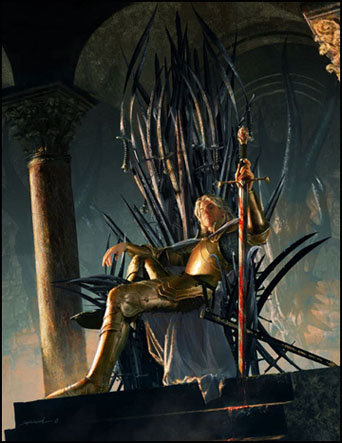
Martin’s plan after that involved a great leap forward over a chronological fissure of about 5 years; instead, encumbered by too many flashbacks covering skipped events, he plummeted into those depths, and had to rethink the next book on the way down. A Feast for Crows (2005) is indeed the worst or weakest installment of A Song of Ice and Fire, but in the same way that “The Shadow of the Hun” is the least of the Turlogh Dubh outings: I remain profoundly grateful for the existence of both. Still, however much of a letdown the fourth Ice and Fire novel was perceived as being, the Solomonic expedient from whence it came, Martin’s decision to cut the original Dance-manuscript in twain and publish the half-with-the-less-charismatic-and-compelling-characters straightaway left readers hopeful that the more glittering prize would arrive a year later. No such luck.
The death of Robert Jordan (James Oliver Rigney, Jr.) before he was even 60 on September 16, 2007 didn’t so much change everything as it aggravated everything. A frost-fanged wind from the Mountains of Mortality blew through A Song of Ice and Fire fandom; GRRM will turn 61 in 2009, and he’s a gent of trenchermanly physique.
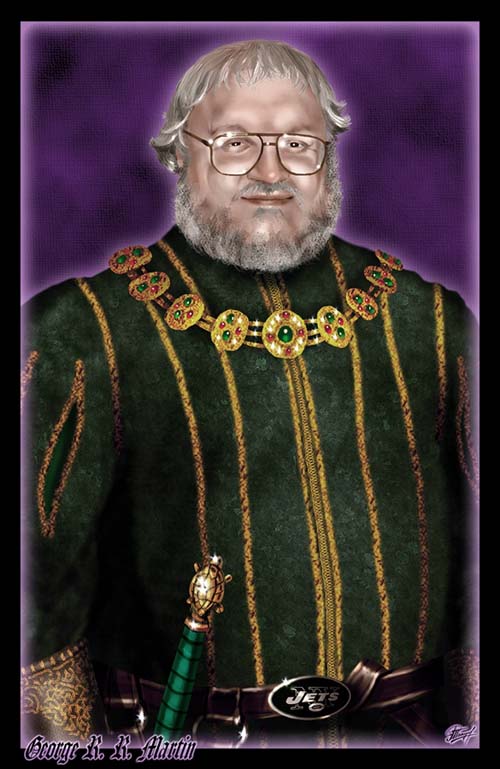
If no further mission-creep occurs and if the gestation of the next book in the series, The Winds of Winter, is comparable to that of A Feast for Crows or A Dance With Dragons, grand finale A Dream of Spring could turn out to be a Thak-sized monkey on the back of a septuagenarian writer. Which is not to say that the careers of the two bestsellers are all that comparable; Leo Grin, in his “The Death and Legacy of Robert Jordan,” was gentler about The Wheel of Time than I could have brought myself to be. I enjoyed The Eye of the World (1990) and The Great Hunt (also 1990), especially Jordan’s here, there, and everywhere nomenclature-borrowings, but liked Frank Herbert’s Bene Gesserit and Fremen of Arrakis better in Dune. By The Fires of Heaven (1993), Jordan was Waist-Deep, Neck-Deep, and then Entirely Submerged in the Big Muddy as floundering gave way to foundering, alopecia-inviting braid-tugging and tweenage bickering suggestive of the worst junior high mixer ever thrown. So without meaning to hurt anyone’s feelings, I’m confident that the completion of wrapup novel A Memory of Light by Brandon Sanderson will constitute no real loss to epic fantasy, to epic fantasy that will endure. A Song of Ice and Fire is a Pale Horse of a different color, a heavyweight contender of Ali-esque magnitude. How to capture the difference between the two series in shorthand? Well, had Darrell K. Sweet been commissioned to do the cover honors for one of the Westeros books, his paintbrushes would have spontaneously combusted on the spot.
So the stakes are league-high and written in letters of blood, as Roy Thomas’ Fatima of Zahmann might put it, and by sharing thoughts on his hobbies and (competing?) interests at his Not a Blog, GRRM has left all too many hostages to fortune, some of whom wear safety pads and NFL helmets. He’s a serious fan of both the Giants and the Jets; were REH to return from death’s grey lands and buttonhole him at the WFC some year, they’d probably talk football rather than shop (see Collected Letters for evidence of Howard in effect urging HPL to go long so he could pass the pigskin to him). Every time Brett Favre threw an interception this season I feared for the future of A Song of Ice and Fire.
That mention of the WFC was intended to convey that Martin is a committed conventioneer; he’s also a collectibles-clutcher, a creator who enjoys the licensing jamboree that his mega-series has brought him. Combine the failure of stopgap measure A Feast for Crows to buy him much time or goodwill, the expandomatic deadlines for A Dance with Dragons, and the self-“incriminating” posts about Sundays spent armchair quarterbacking in front of the plasma screen rather than keeping his nose to the Valyrian grindstone, and fans have been out-howling the Stark family’s direwolves. Morgan Holmes staged a public breakup with Martin here, and if the bloggers at Finish the Book, George have a love/hate relationship with A Song of Ice and Fire and its author, hate is Ganges Groin Gouge-ing the hell out of love by this point. GRRM, Lord of the Onion Rings, Jabba the Gut, Captain Hamerica, and Incredible Bulk, is accused of everything from participation in pancake-eating contests to craven Vietnam War-duckage. One Fiddler on the Periphery was pushed into posting “In Defense of George R. R. Martin.” Where the Finish the Book guys lose me is when they curdle from pessimism into nattering-nabob-of-negativism, from Let’s face it, A Dance with Dragons is never coming out to Let’s face it, A Dance with Dragons is never coming out but if it does, ’twill suck.
Fobbing off some other fantasy series, or Martin knockouts like steamvamp classic Fevre Dream (1982) or the Songs the Dead Men Sing collection (1983) on someone waiting and waiting for Dance is, however well-intentioned, very much like advising some of us who were jonesing to read In the Wake of the Night back in the Eighties to find a sword-and-sorcery Methadone clinic. Rusty Burke once wrote an eloquent piece arguing that Karl Edward Wagner owed his fans and his own perfectionist inclinations his best work rather than his speediest. No matter how much readers wanted In the Wake of the Night, Black Eden, or Silver Dagger, Wagner himself surely wanted them more and wanted them to be more, deadlines be damned. Alas, we know how that turned out.
But until the disappointments of late Martin has been much more of a pro, much more consistently productive, than Wagner ever managed to be for all his brilliance. And he’s excelled in each of the fantastic genres, in which context I’ll cite his remarks at the start of the “Heart in Conflict” section of Dreamsongs Volume II:
The House of Fantasy is built of stone and wood and furnished in High Medieval. Its people travel by horse and galley, fight with sword and spell and battle-axe, communicate by palantir or raven, and break bread with elves and dragons.
The House of Science Fiction is built of duralloy and plastic and furnished in Faux Future. Its people travel by starship and aircar, fight with nukes and tailored germs, communicate by ansible and laser, and break protein bars with aliens.
The House of Horror is built of bone and cobwebs and furnished in Ghastly Gothick. Its people travel only by night, fight with anything that will kill messily, communicate in screams and shrieks and gibbers, and sip blood with vampires and werewolves.
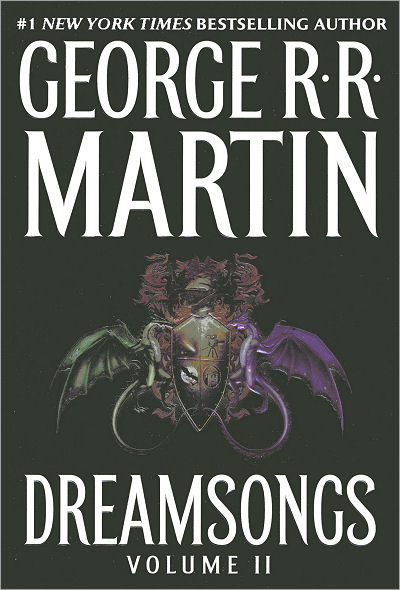
Only Tanith Lee has shuttled between those three Houses as successfully as Martin; Dan Simmons is as talented at horror and science fiction but hasn’t tried his hand at “high” or “pure” fantasy. Why is GRRM so epochally epic a fantasist? Different readers would obviously answer that differently. As with Clark Ashton Smith in several of the best Hyperborean stories and Tad Williams in Memory, Sorrow and Thorn, the word “winter” for him always seems to be preceded by a parenthetical “Fimbul,” and what we have is as much a realm as a season, a haunt of “raiders and giants, wargs and skinchangers., mountain men, salt sea sailors, ice river cannibals, cave dwellers with dyed faces, dog chariots from the Frozen Shore, Hornfoot men with their soles like boiled leather.” And beyond all of them, the Others (a term Martin put to chilling use long before the producers of Lost came along). What’s more, he likes his wolves and dragons even more than his Jets and Giants, and while A Song of Ice and Fire is short on “good guys,” humans who appreciate and ally with wolves and dragons are often “better” if not necessarily good. Violet of eye and violent of death, Martin’s dethroned dynasts the Targaryens of Old Valyria are glamorpusses to rival those other dragonlords, the Melnibonéans. “Blood of the Dragon,” which extracted the Game of Thrones storyline of Daenerys Stormborn, the last of the Targaryens, notched Martin the 1997 Best Novella Hugo, and I’m sure the tableau when the eggs that are the princess’ patrimony hatch at long last on the funeral pyre of a great khan sealed the deal. Three newborn dragonets — one cream-and-gold, one green-and-bronze, one black-and-scarlet — imprint on their wingless “mother”:
As Daenerys Targaryen rose to her feet, her black hissed, pale smoke venting from its mouth and nostrils. The other two pulled away from her breasts and added their voices to the call, their wings stirring the air, and for the first time in hundreds of years, the night was alive with the music of dragons.
At the February 2007 NYC Comic-Con a Q & A session yielded valuable information about the Dragons and the George: Martin apparently confirmed that his dragons are four-limbed (counting their wings and hind-legs; they lack even vestigial forearms) and although sapient, will be unspeaking, never developing “into the sort of dragons we see in Tolkien or Le Guin. . .The Targaryens rule by fire and blood, and that’s what the dragons represent in the story.” As much as I enjoy Fafnirian fluency, I trust Martin to give his saurian’s major, if non-speaking, roles.
The Targaryens are just one elegantly perverse example of how backstory and story-yet-to-come wander the halls of A Song of Ice and Fire as does Eallal Kull’s palace, and what-has-gone-before is the more insistent specter. The tragedies and trysts of the parents and elder siblings of Martin’s dramatis personae are constantly alluded to but never spoonfed to us, with Daenerys’ lost brother Rhaegar, the Prince of Dragonstone “crowned in mist and grief,” especially lingering in the memories of those who loved or hated him. The series abounds in stories behind stories, stories beneath stories, boneyards and barrows of untold stories, as when a POV characters seeks reluctant refuge in the Nightfort, a ruined stronghold:
It was here that Night’s King had reigned, before his name was wiped from the memory of man. This was where the Rat Cook had served the Andal king his prince-and-bacon pie, where the seventy-nine sentinels stood their watch, where brave young Danny Flint had been raped and murdered. This was the castle where King Sherrit had called down his curse on the Andals of old, where the ‘prentice boys had faced the thing that came in the night, where blind Symeon Star-Eyes had seen the hellhounds fighting. Mad Axe had once walked these yards and climbed these towers, butchering his brothers in the dark.
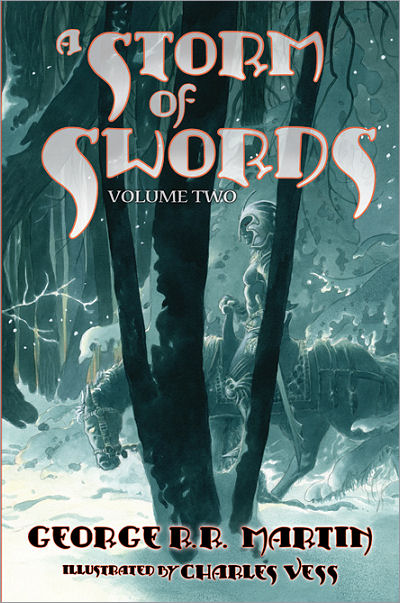
Me, I don’t think GRRM has misplaced either his work ethic or his Muse, but I fret a bit about whether the latter might be getting to be a bit too much for him, almost as if a man approaching retirement age had lucked into a much younger, boundlessly-inventive-and-downright-gymnastic girlfriend. Infatuation can be the most seductive of quagmires, and I suspect Martin of loving not wisely but too well, of doting on the Seven Kingdoms of Westeros, the wildling lands beyond the Wall, and the exotic cities of the East from which Daenerys is preparing to stage her dragon-winged war of restoration. This authorial besottedness is mostly all to the good, with the possible exception of heraldry; armorial bearings are threatening to take over GRRM the way brocade did Robert Jordan.
To take the pulse of an ever-more-impatient readership, I’ve sampled as many forum threads as I could find, and my favorite post by far was this from an “A. Whitehead,” of that storied old legionary city Colchester, at Amazon:
I sometimes ponder what would have happened if the Internet had been around in the 1930s. A few months after The Hobbit came out, fans would have crowded onto www.tolkien.com to find out how the sequel was coming along. Years and years would tick by and Tolkien would keep saying ‘he was just a few chapters’ from the end. People would get sick of it and move on (or more likely get drafted and fight in WW2, but bear with the analogy here). Tolkien was in his fifties and not trim. People would be moaning about him doing another job as well as writing, they’d scream with frustration when he announced he was chucking out 200 pages and starting again from scratch, they’d scream about him going to poetry and English literature conferences, they’d moan every time they heard he was moving house or going down the pub with CS Lewis. They’d cry about writer’s block and make nasty comments about his health. Finally, ten years later, he finishes the book. Much applause. Then he takes two years just to rewrite and edit it, during which time the moaning reaches new heights. Then he has a massive bust-up with his publishers which delays the book by another FIVE YEARS. By this time, no doubt suicides would have taken place. People point out that CS Lewis has written and published an entire, reasonably decent seven-book series in half the time Tolkien’s taken to write one book.
Then The Lord of the Rings comes out. And I strongly suspect all would have been forgiven, even after it got split in three (and the third book, supposed to come out just a couple of months after the second, gets delayed and delayed again, to the fury of the fans).
And the day after The Return of the King comes out, they start clamouring for The Silmarillion. 22 years later, they finally get it.
That’s exactly how it would have been; mercifully, Tolkien, who even back in the low-tech Sixties was driven to describing his following as “my deplorable cultus” in a letter to Norman Davis, was spared the age of cyber-invective (although he might have had a premonition of flame wars; recall the vision of Denethor’s charred hands that show up as a grisly screensaver on the palantir he used so secretively). The professor’s reaction to slashy Aragorn/Legolas fanfic is best left to the imagination, but we can have a little fun conjuring up the rush to keyboards upon completion of the Weird Tales serialization of The Hour of the Dragon. “Worst. Conan. Story. Ever.” Thus typeth Pulp Guy, before snarkily zeroing in on the Tamar/Tarantia and Numedides/Namedides discrepancies. Aggro-addicted male fans would have felt gypped because Conan does not put Tarascus to the sword and Belverus to the torch. Maenad-eyed female fans would have reached right through their monitor screens to snatch Zenobia bald for moving in on their boyfriend. Pedantic persnicketeers determined to look a gift destrier in the mouth would have called for the immediate expulsion of the novel from the mainstream continuity of the Conan series (excessive cannibalization of “Black Colossus” and “The Scarlet Citadel,” Howard’s obviously out of ideas!)
So although laughs can be had at Finish the Book, George, I usually prefer to revisit the interstitial material in Quartet: Four Tales from the Crossroads (2001) and the compendium Dreamsongs, because Martin is himself quite funny: “. . .all you ever heard about writing for Hollywood was the horror stories. I’d read Harlan Ellison’s Glass Teat, after all. I’d even read The Other Glass Teat. “Which reminds me; in view of [redacted]’s recent Donald Westlake eulogy, here’s something about the mid-Eighties, when Martin’s the-Sixties-are-unquiet-in-their-grave rock-and-roll horror novel The Armageddon Rag “had all the hallmarks of a big bestseller save one. No one bought it,” and he was forced into a Babylonian captivity in Hollywood. An acquaintance hit him up to submit a script for the CBS revival of The Twilight Zone, an adaptation of a heartwarming story entitled “Nackles”:
Every god must have his devil. Nackles was the anti-Santa. On Christmas Eve, while Santa Claus is flying around the world in his sled, sliding down chimneys to leave presents for good boys and girls, Nackles is moving through pitch-dark tunnels beneath the earth in a railroad car pulled by a team of blind white goats and crawling up through the furnace grate to stuff bad boys and girls in his big black sack.
. . .”Nackles” seemed to me to be a perfect Twilight Zone, given a faithful adaptation. I also took no little pleasure in imagining the thrill the sale would give Curt Clark, this obscure, forgotten little writer who I pictured teaching English composition at some community college in Nowhere, North Dakota or Godforsaken, Georgia. It turned out that “Curt Clark” was a pseudonym for Donald E. Westlake, the bestselling author of the wonderful Dortmunder series, and a hundred other mysteries and crime novels, half of which had been turned into feature films.
Unfortunately, the powers that be proved to be as blind as the anti-Santa’s goat-team, and neither Martin’s version of the story nor another try by Harlan Ellison passed muster (the spirit of Nackles lived on in “A Very Supernatural Christmas,” a third season episode of Eric Kripke’s Supernatural written by Jeremy Carver).
Of his pendant-novella “The Hedge Knight” (the first in a toothsome series of picaresque adventures set in the Targaryen-ruled Westeros two generations before A Song of Ice and Fire) Martin writes
“The Hedge Knight” is high fantasy, nothing could be plainer. Or could it? Doesn’t fantasy require, well, . . .magic? I have dragons in “The Hedge Knight,” yes, indeed. . .on helmet crests and banners. Plus one stuffed with sawdust, dancing on is strings. Oh, and Dunk remembers old Ser Arlan talking about seeing a real live dragon once, perhaps that should suffice. If not, well. . .you can say “The Hedge Knight” is more of a historical adventure than a true fantasy, except that all the history is imaginary.
Except that all the history is imaginary — could we be much closer to Robert E. Howard and those Thurian and Hyborian millennia he hand-wrote in between the more paleoanthropologically or archaeologically documented of Father Time’s annals? Before Westeros won me over to the extent that comparisons became moot, I used to tell myself that the old civil wars that so irradiate the mere thought of of Trocero and his Poitanians insofar as the Aquilonians of the central provinces are concerned were probably much like the atrocity-spirals of A Clash of Kings and A Storm of Swords. Speculating as to what Howard would or would not have enjoyed in terms of our popular culture almost always says more about the person engaging in the speculation than about Howard, but my guess is that he would have responded to the bastardliness, the utter absence of a sense of Wright-and-wrong, of the Westeros novels:
“Duoquor’s Pit has a fine folly scheduled for the evening. A Bear and three small boys. One boy will be rolled in honey, one in blood, and one in rotting fish, and [onlookers] may wager on which the bear will eat first.”
As George Steiner wrote in The Death of Tragedy, “To the medieval eye, the heavens of state were filled with portentous stars, dazzling in their ascent but fiery in their decline. The fall of great personages from high places (casus virorum illustrium) gave to medieval politics their festive and brutal character. “”Festive and brutal” is perfect for A Song of Ice and Fire, or perhaps it’s more accurate to say that festivity is a coping mechanism for the brutality that results in great personages falling like Skylab-debris. Like the Targaryens, the series still has the potential to rule, and for that reason the prospect that really causes me to gibber to myself is not that GRRM will go the way of KEW or Robert Jordan, but that he might be pressured into pulling a Dark Tower.
My emotional investment in Stephen King’s seven-part sixgun-and-sorcery sequence dates back to 1978 (King’s, of course, dates back to 1970) when, as a college freshman, I was waiting to Amtrak it home from Penn Station for Thanksgiving. The Magazine of Fantasy and Science Fiction with “The Gunslinger” in it caught my eye, so I sprang for the issue and instantly sprang upon the story. Within paragraphs I knew this was storytelling as steeped in Sergio Leone and Ennio Morricone as were George Gilman’s Edge novels, only with an eschatological heightening.
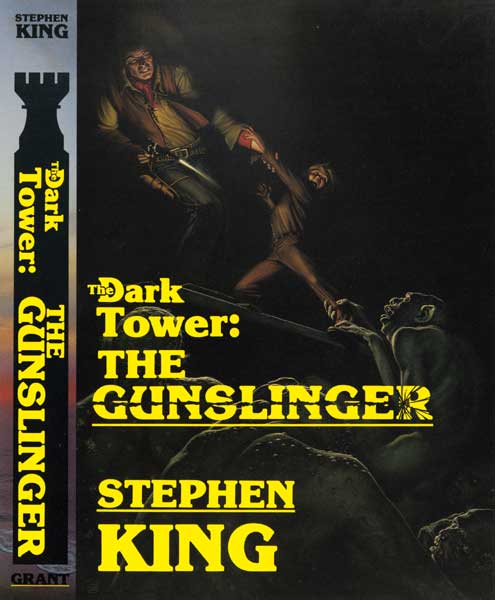
For the uninitiated, the series graduated from The Magazine of Fantasy and Science Fiction to Donald M. Grant hardcovers and mass-marketry, ultimately consisting of The Gunslinger (1982), The Drawing of the Three (1987), The Waste Lands (1991), Wizard & Glass (1997), Wolves of the Calla (2003), Song of Susannah (2004), and The Dark Tower (2004), peaking with the fourth novel, my favorite weird Western of all time and a stunning. youth-recapturing evocation of first love. What happened? King was far from washed-up or written-out — witness novels like Bag of Bones (1998) and Lisey’s Story (2006), or murderers’-row collections Everything’s Eventual (2002) and Just After Sunset (2008). The crucial fact is that the early Dark Tower volumes were written as they revealed themselves to King, when they left him no choice but to put them on paper (and back then actual paper would have been involved). A phrase from the 2008 campaign, “the fierce urgency of now,” comes to mind. But then in 1999 King learned just how frangible a pedestrian can be, and the resulting injuries knocked him not only into the middle of next week but into a new dutifulness about getting the series done. And Mitra, does it ever show. Let me apologize for my inability to avoid sphincteral imagery here; the last 3 novels read as if squeezed out. Perspiration, its uniform pre-soaked in flopsweat, came into the game to replace inspiration; villains were trivialized, erratic whimsy held sway over all, the Robert Browning poem that was such an eidolon/blueprint for the whole sequence was betrayed, and Stephen King himself became a page-hogging presence in a way appallingly different than HPL’s famous observation about REH being in every one of his stories. Song of Susannah is for my money King’s nadir-novel, much less readable than Roadwork, Cycle of the Werewolf, or The Tommyknockers. I liked the lyrically recursive coda to The Dark Tower more than Leo did, but by then the damage had been done more destructively than anything since the white magic gangbang that sabotaged It back in 1986.
In summation, here’s hoping A Dance with Dragons will turn out to be a Chinese Democracy, a long-running joke that undercuts its own punchline by finally being released, not a Book on the Edge of Forever like The Last Dangerous Visions or a Crawling Chaos like Wolves of the Calla. I will continue to be faithful to A Song of Ice and Fire in my fashion, dallying along the way with Steven Erikson’s Dust of Dreams, Tad Williams’ Shadowrise, R. Scott Bakker’s The Judging Eye, and Joe Abercrombie’s Best Served Cold while wishing all that the Dance would hurry up and start, already. Martin may have earned a few doubts, but he’s also earned my (nuanced) loyalty — provided he can keep himself from writing a Santa Fe-residing novelist named George R. R. Martin into the series.

